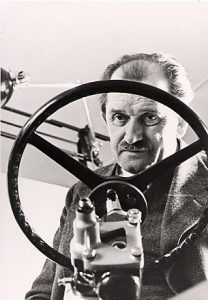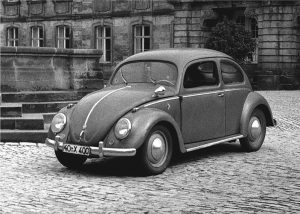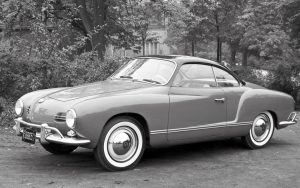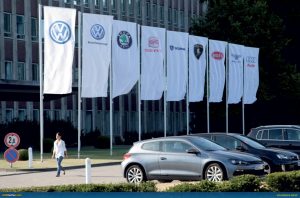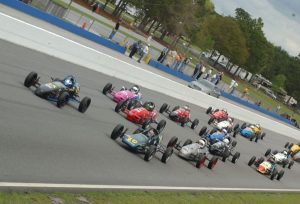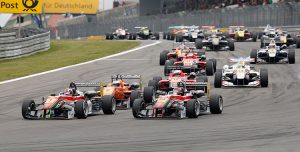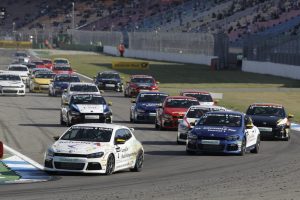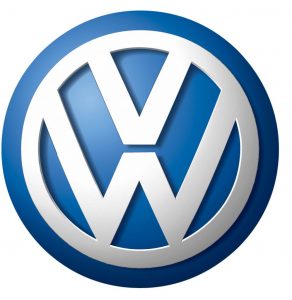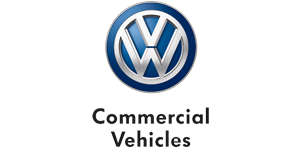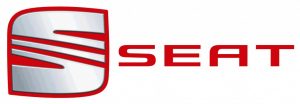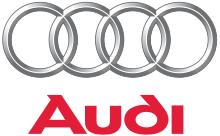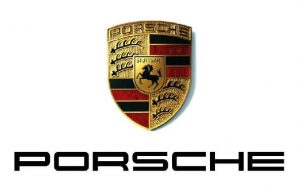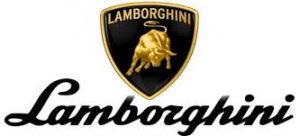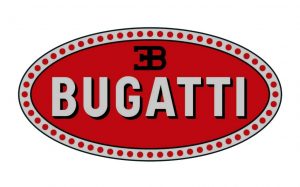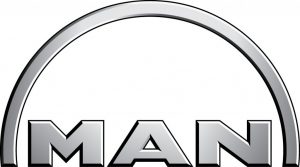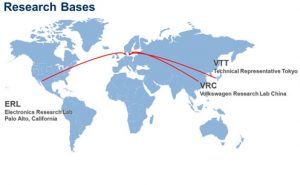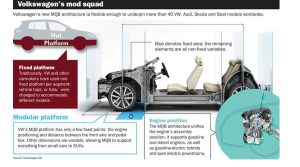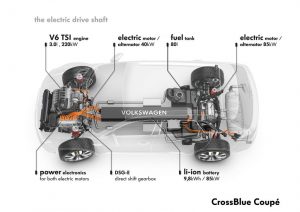Volkswagen’s inception is, as peculiar as it may seem, related to Adolf Hitler. Prior to his megalomaniac plans of conquering Europe, he dreamt a car that was compact, reliable and cheap enough to be bought by the average German citizen. As a consequence, Ferdinand Porsche was given the role of creating such a vehicle, with the target selling price being 1,000 DM. Thus, on the 28 of May 1937 the “Geselschaft zur Vorbereitung des Deutschen Volkswagen mbH” factory – and brand – was created, only to be renamed into “Volkswagenwerk GmbH” a year later. The production plant was relocated from Berlin to Wolfsburg, an urban centre created with the sole purpose of housing the manufacturing works and the human resources needed for mass producing “the people’s car”.
However, due to the advent of World War II, all plans were halted and the plant was reassigned to produce military vehicles and weaponry. After the war had ended, the works were taken over by the British forces, under the leadership of Major Ivan Hirst. The Volkswagen Type 1 – or as the world would get to know it, the Beetle – began production and in only two years time, in 1947, the first units were ready for export. At the Hanover Export Fair, the model was displayed in front of an international audience and Dutch businessman Ben Pon becomes the first to show interest in selling it over the borders. Despite the incredible efforts of the factory and ownership, the initial sales figures out of West Germany’s borders were extremely disappointing. Nonetheless, marketing campaigns that praised the compact dimensions of the car had eventually reached the audience and the Beetle proved to be especially popular amongst the younger section of the market.
The one millionth Beetle rolled off the production line in 1955, marking the beginning of a successful era in the automotive industry for the manufacturer. The focus on mass production, together with the interest shown for a global market, rather than a local one, transforms Volkswagen into a manufacturer which, in certain parts of the world, dominated more than half of the automotive market share.
Riding on this wave of success, the first commercial vehicle, the Type 2 or the “Bully” is introduced in 1950. Following its plans of expansion, numerous sales centres are inaugurated in key areas such as Canada, Australia and the United States. 1964 marks the year in which 33 % of the German market consists of VW cars, while its presence grows throughout Europe. However, the competition sends the German manufacturer into a temporary collapse, as in the period between 1966 to 1967 sales plummet.
Changes are made in the structure of the company. Consequently, “Volkswagenwerk GmbH” becomes “Volkswagenwerk Aktiengesellschatt” and more than 60% of its capital is sold as “people’s shares”, while the remaining 40% is equally split between the state of Lower Saxony and the central government, in an effort to maintain the authority of the state over the business. Auto Union GmbH (Audi) is incorporated into what is to become the VW Group, thus widening the product range of the manufacturer.
Meanwhile, the Karmann Ghia coupe (with a cabriolet version later on) is introduced and due to its elegant, yet sporty styling, it becomes a sales triumph. On February 17th 1972, the 15th million Beetle rolled off the production line, beating the record held by the Ford Model T, but its technology proved to be too old to be attractive to people and only its compact dimensions and low fuel consumption still made it relevant. The Auto Union division’s experience with water cooled engines and front wheel drive technology came into play, as the research efforts lead to the birth of the VW Golf (or Rabbit in Canada and the US), in 1974. The distinct shape, reliable engine and impressive dynamics made it into an instant success, leading to the creation of the Golf GTI later on, a performance version based on the stock vehicle, featuring flared wheel arches, wide track tires and halogen headlamps, while a 4 cylinder, in-line engine developing 110 bhp served as a power plant.
Later models were developed, amongst which the Golf Cabriolet, the Scirocco, the Passat and the super compact Polo, in 1976. Volkswagen Group’s portfolio expanded, in the 1980’s, with the addition of Seat and Skoda, while a decade later, the smallest supermini to be produced by the car maker, the Lupo, was born. Best known for its then unmatched fuel economy (78.4mpg) the Lupo has remained a true icon for VW. Gradually, Audi was given the task of representing the premium automotive division, rivalling Mercedes and BMW and eventually becoming an integral part of Germany’s “Big Three”.
Presently, the VW Group is responsible for a market share of 24.8% in Western Europe (or roughly one in four cars produced by the Group), while the sales revenue in 2013 reached €197 billion. Comprised by twelve brands – Volkswagen Passenger Cars, Audi, Seat, Škoda, Bentley, Bugatti, Lamborghini, Porsche, Ducati, Volkswagen Commercial Vehicles, Scania and MAN – the Group represents a major player both on local and global grounds.
Volkswagen – Motorsport
Spanning nearly 48 years, Volkswagen’s motorsport history is one of the most fascinating in the automotive world. Starting with Beetle parts and ending up producing world champions, its heritage lives on to this day, with its double win in 2013’s WRC, setting a record for the first make to win both the driver and the manufacturer’s title in its debut season.
Formula Vee 1965 –
The first corner stone was laid in 1965 with the birth of “Formula Vee” – the first organized racing series for junior drivers. Ferry Porsche brought the idea from the 1960’s United States, claiming “Motorsport for all!” The Formula Vee’s philosophy was simple – racing cars manufactured mostly from parts available in the VW Beetle. Thus, components such as the front axle, steering rack, engine and gearbox were used as a sub-assembly, while the body shell went over it. 1971 saw the introduction of Formula Super V, which carried on until its demise in 1982. Serving as a testbed for young talents, Formula Vee gave birth to numerous Formala 1 drivers, such as Niki Lauda, Emerson Fittipaldi, Jochen Mass, Nelson Piquet, Jochen Rindt and Keke Rosberg.
The first ever one make cup for VW was inaugurated in 1976, at the Hockenheim Motordrom and was known as the VW Junior Cup. The governing principle – that of equality of chances, is still present in one make cups all over the world. The VW Scirocco was the vehicle of choice that started it, while the Golf I GTI replaced it in 1979. Only one year after the debut of the Junior Cup, VW enters the rally world, in 1977, with a rally prep, 121 horsepower Golf I GTI, driven by Jochi Kleint.
Formula 3 1979 –
1979 marked the year when the manufacturer entered the Formula 3 competition, but not as a team, but an engine manufacturer, having produced legends such as the septuple F1 champion Michael Schumacher and the eightfold LeMans winner, Tom Kristensen. Vokswagen was not a company with humble goals, so after the F3 debut, it set its goals on entering the Paris-Dakar race. Thus, in 1980, a rally specification VW Type 183 Iltis entered the race –and won, despite initial ridicule from competition, proving that looks are not everything. Three years later, the VW Polo Cup was inaugurated. Also a one make cup, it employed an 88 horsepower naturally aspirated engine Polo supermini. Its successor, in 1986, was fitted with a supercharger, reaching 112 horsepower, causing quite a commotion around the little car. In the same year, a 193 horsepower Golf GTI participated in the Group A races, with Swedish pilot Kenneth Eriksson behind the wheel and his German colleague, co-pilot Peter Diekmann. The pair had a smaller, lighter car compared to the competition, while the VW team had a considerably smalled budget than its rivals. However, despite the setbacks – and the odds – the VW team secured a world championship title at the end of the racing season.
In 1991, a Golf G60, fitted with a powerful 282 horsepower engine and a G-Lader (a scroll type supercharger) won the German Rally Championship, with Erwin Weber and Manfred Hiemer behind the wheel.
24 Hours Nürburgring Race
After quite an absence, VW returned to the 1997 24 Hours Nürburgring race with a Golf III diesel. A 1.9 litre, 170 horsepower TDI served as its power plant. Surprisingly – or not – the car secured second place in the Green Hell. The same year, the manufacturer entered Formula Kӧnig as an engine supplier, fitting the cars with a 1.4 litre 120 horsepower four cylinder engine. 1998 marked the return of the German car maker in the one make cup championships, after a nine year break, with the introduction of the Lupo Cup, an inexpensive solution for those who wanted to experience the thrill of racing on a circuit; two years later, the Beetle Cup was founded, only to be discontinued in 2002. The race-ready Beetle was fitted with an aerodynamic body kit, a roll cage, a 204 horsepower V6 with an automatic 6 gear transmission and had a Bilstein and H&R chassis.
Dakar Race
In 2003, after a 24 year period of non-participation, VW returned to the Dakar race, bringing the Tarek into play. Designed by Italdesign, it was a two wheel drive rally prototype, driven by Jutta Kleinschmidt, the only woman at that time to win the fabled race. However, a victory could not be attained, despite the intense efforts of the driver. One year later, in 2004, the Lupo Cup becomes the Polo Cup, as the former model is phased out of production.
In 2005, a Golf V GTI was VW’s choice for the endurance race of Nurburgring. Having a 300 horsepower 2.0 litre TFSI front wheel drive engine, it managed to secure the first place in the SP3T class and an eight place overall. Not shy of participating in even more events, Volkswagen entered the Formula 3 Euro Series in 2007, with victories secured in 2008, 2010 and 2011. Participation in the German Formula 3 Cup started in 2008, with victories obtained in the following three years. Moreover, a Baja race-prep Touareg secured victory in the grueling 1,000 kilometres off-road race in 2008, with drivers Mark Miller and Ryan Arciero behind the wheel.
2009 was a hallmark year for the Formula 3 drivers, as Eduardo Mortara won the first place in the season finale in Macau, while Jean Karl Vernay secured second place, making it a memorable victory. That same year, Volkswagen debuted in the British Formula 3 races. Between 2009 and 2011, out of 80 races, 53 were won by VW drivers. Driven by passion, the drivers behind the wheel of a diesel Touareg won the Dakar race, making it a first for a diesel powered vehicle to obtain victory in the arduous race.
Scirocco R Cup
In 2010, Volkswagen introduced the Scirocco one make cup. Nothing unusual so far, but the novelty behind the concept was that it was the most environmentally friendly event of this kind, with all the cars being powered not by diesel fuel or petrol, but by natural gas. An unprecedented initiative, the Scirocco GT24-CNG car was capable of cutting up to 80 per cent of its emissions, while retaining a respectable power rating of 270 horsepower. One year later, VW wins the Dakar race for the third time in a row.
2013 represents another landmark, as drivers Sebastien Ogier and co-pilot Julien Ingrassia become world champions in the WRC. Team VW, with a Polo WRC, managed to secure both a driver’s and a manufacturer’s title, also setting a record, as no other team has managed this feat in its debut season.
Volkswagen Brand
Volkswagen no longer represents a solitary brand, but a group of products, reunited under the moniker of VW Group. Totalling 12 powerful makes that cater from the most affordable to the ultra luxurious, the Group dominates more than 24 per cent in the Western European market and over 12.8 per cent worldwide, making it into one of the most prolific and wide-reaching car manufacturers on the globe.
Although the Group represents the official namesake for the entire collection of brands, each make is given sufficient independence to operate separately on the market. Apart from the automotive sector, the Group is active in diverse fields such as the manufacturing of large displacement engines for industrial power plants and marine applications, chemical reactors and turbochargers, steam and gas turbines and compressors. Moreover, it also manufactures components for wind turbines.
Aside from mechanized production, its services branch spans across different areas. Starting from the regular sales services to dealer and customer financing, managing vehicle fleets for businesses and corporations, as well as offering banking and leasing solutions and administering insurance activities.
Globally, the Group manages no less than 107 production plants in 27 countries, with a workforce consisting of approximately 527,800 people. An average of 39,350 vehicles is produced every day, while the resulting machines are sold in 153 countries.
As of 2013, the Volkswagen Group is the third largest carmaker worldwide and holds the first place in Europe. It landed on the eighth place in the 2014 Fortune 500 list, just above Toyota (ninth place), ranking higher than any automaker, with only the petroleum giants ahead of it. The sales for 2012 equated to 9,276 million vehicles, with the figure mounting to 9,731 million in 2013, representing 12.8% of the global market share in the car passenger sector. Moreover, the sales revenues for 2012 were declared to be €193 billion, while the total figure increased to €197 billion in 2013 and the annual revenue (after tax) was reported to be €9.1 billion.
Volkswagen Sub-Divisions
Volkswagen Passenger Cars represents the division in charge of producing small, compact and large size vehicles (stopping at SUV/crossover level) that bear the famous blue VW logo. Making use of the fabled “Volkswagen – Das Auto” slogan, the make stands for quality, reliability and value for money. Offering iconic models that have stood the test of time and have almost become an industry standard, it has steadily increased its market share on the local and global market until its prestige alone recommends its products. The VW Golf, for examples, is a perfect exemplification of filling a market gap that ultimately gave birth to the hatchback craze that still continues to this day. As the company philosophy states, the brand is driven by innovation and by market demand, introducing novel features at an affordable price level, focusing primarily on the needs and preferences of the customers.
The second branch that bears the VW logo is aptly named Volkswagen Commercial Vehicles and includes pick-up trucks (such as the Amarok), compacts such as the Caddy and large size machines such as the Transporter, Crafter and Multivan. Created with the aim of reaching customers that value fuel economy and reliability, the products fill a niche gap in the market. From private to corporate and governmental institutions, the automobiles produced by the Commercial Vehicles division caters for every need that the Passenger Car division cannot fulfill, in an attempt to secure a market share that may otherwise be occupied by a rival producer.
Having been incorporated in the Group in 1986, SEAT represents a brand that is geared towards the younger sector of the market. Thus, the products coming from the Spanish car maker are characterized by a dynamic design, with ether flowing surfaces or sharp angles, depending on the car in question. No less than 21 different models are produced by the factories in Prat, Barcelona and Martorell, ranging from the iconic Leon to the Alhambra or the Toledo. Although lately regarded as the black sheep of the VW Group, having produced losses of over €150 million in 2013, SEAT is betting on emotional design and its trademark term of “enjoynering” to regain lost territory in the global car market.
ŠKODA represents a name with a rich history behind it, being in existence since 1895. Bought in 1991 by the VW Group, Skoda has been positioned on the market as the most affordable brand of the corporate empire. Simplicity, reliability and outstanding value for money make the Czech brand into a reasonable choice for the budget conscious. With seven models produced, available in no less than 100 countries, the company delivered over 921,000 vehicles worldwide in 2013.
A member of the German “Big Three”, Audi is a leading premium car manufacturer. Positioned on the market as a direct competitor to the other two premium companies in Germany, namely BMW and Mercedes Benz, Audi is VW Group’s spearhead brand when it comes to first-rate products. Defined by terms such as power, sportiness and elegance, the brand employs a rather conservative line of design for its products, focusing on progressively bringing new elements into play without standing out too much from the “German” pattern. Both a positive and a negative, this means that all the vehicles in its range, from the A1 supermini up to the opulent A8 L limousine will share the same overall lines, save for minute differences. While keeping a common design language in order to build brand awareness and unity, it strikes you more as an “Attack of the clones” sort of thing.
Although Porsche has always shared mechanical components with VW products – including the original Beetle – it has only been a part of the VW Group since 2012. Having a rich motorsport history in its wake, Porsche continues to represent one of the most successful sports car manufacturers worldwide. With a strong presence in key markets such as Europe, China and North America, it managed to sell over 162,000 vehicles in 2013, more than ever before in its existence, setting a new record for the car maker. With an athletic design, premium interiors and potent power plants, Porsche has established itself as an industry standard.
The highest ranking luxury car maker in the Group’s portfolio is Bentley, part of the Group since 1998. Designed to compete with another bastion of luxury, namely the BMW owned Rolls Royce, Bentley’s products represent the pinnacle of opulence and grandeur on four wheels. Characterized by the “Luxury Performance” creed, each of the approximately 10,000 vehicles produced every year in the Crewe factory is tailor made to the customer’s specifications and no expenses are spared in the process. The Continental GT, Continental GT Convertible, Continental GT Speed, Continental GT Speed Convertible, Flying Spur and Mulsanne are the models currently in production, while a luxury SUV is predicted to be fabricated by the make in the near future.
A worldwide icon, Lamborghini has also been a part of the group as long as Bentley, being acquired in 1998. A low volume sports car manufacturer, Lamborghini has produced 2,100 vehicles in 2013, generating over €458 million in revenue. The Huracan and Aventador models are currently in production, although the make also produces extremely exclusive variations of its products or entirely new models, sold to select customers. Although having German patrons, the Italian maker has kept its independence, with its products having a distinct Italian design, distinguished by sharp and angular lines.
Centered on the philosophy of “Art, Forme, Technique”, Bugatti has been an integral part of the group since 1998. With a vast racing history behind it, it was only naturally that the products designed were to follow the same legacy. Thus, one of its most iconic products, in the form of the Veyron, was born, with the concept having two main goals: 1,000 horsepower and 400 km/h. The production vehicle managed to reach (and break) both targets and it redefined the concept of “supercar”. Today, limited editions of the vehicle are produced until the number will run out, time when another model is set to take its place.
Undoubtedly one of the most well known motorcycle producers on the globe, the Italian brand Ducati has been acquired by the VW Group in 2012. Only one year since it was purchased, the make produced €450 million in revenue, having shipped no less than 44,287 examples worldwide. Defined by craftsmanship, uncompromising performance and unique dynamic capabilities, the sports bikes produced by Ducati are not only lightweight racing machines, but rolling works of art with a soul.
Acquired in 2008, the Swedish manufacturer Scania is an established producer of large size vehicles since its inception, in 1891. The brand produces full size lorries, buses and engines designed for the heavy/shipping industry. Having delivered over 80,000 vehicles worldwide in 2013 and generating revenue in the order of €974 million, Scania represents a powerful player in the automotive industry.
A huge presence in the field of land transportation, MAN is Europe’s third largest truck manufacturer. Besides producing heavy lorries, the product range of the company includes busses, turbo machinery, diesel engines and gear units. Once Scania’s competitor, it now represents an ally on the global market, contributing to the augmenting of heavy automotive technology. The brands is expected to make a comeback after revenue has fallen to €457 million in 2013, due to weak demand of heavy haulage machinery in key markets such as Russia, Europe and Latin America.
Volkswagen Financial Services AG represents the service branch of the VW Group and currently holds the title of the principal supplier of financial services in Europe. With more than 5,623 employees representing its human resource base and having license and share holding agreements with companies spread in over 40 countries worldwide, it is a remarkable international presence, with over €87.4 billion generated in 2012.
Volkswagen – Future
Holding the title of the largest manufacturer in Europe and the second on a global scale, the Volkswagen Group is under a lot of strain, both in maintaining its positions and bettering them.
VW became the second largest car manufacturer on the globe in 2013, when its sales figures went public: 9.73 million vehicles have been shipped and sold worldwide, taking GM’s spot, which sold 9.71 million. Toyota remains ahead, with 10.32 million cars sold, but the VW Group’s goal by 2018 is to reach the 10 million mark and, more importantly, to take the crown from the Japanese automaker, thus becoming the number one car manufacturer.
Thus, the German based corporation has made intense efforts in increasing its portfolio of brands – evident throughout the years, with vehicles ranging from the most affordable to the most opulent. Moreover, the automotive industry is not the only field in which it activates, as its activities span across industrial and marine applications, wind turbine and steam operated machinery, while a separate venture, entitled Volkswagen Financial services is in charge of banking, leasing and insurance activities on a global scale.
Investment in innovation is a must, which is why the Group has established research centres. The purpose of these centres is to study, discover and anticipate trends, fill market gaps and reinvent current applications as well as to introduce novel technology in the automotive industry. Having an international collective, with the central control point set in Germany, intensive research activity is done, both through internal exploration and cooperation between VW and various worldwide partners. Wolfsburg represents the headquarters of Group Research, while three other hubs, namely ERL (Electronic Research Lab) in Palo Alto, California, U.S., VTT (Technical Representative Tokyo) in Japan and VRC (Volkswagen Research Lab China) contribute to the expertise, providing technology and human resource scouting in addition to strategic partnership orientation for all the Group’s brands.
Research vehicles – produced by these centres – were experimental cars that incorporated technology too, new to be introduced in series production. Thus, through thorough testing, only the most useful would be later on, introduced. Innovations such as the DSG gearbox, automatic parking system and the pump/nozzle technology all stem from research vehicles and owe their existence to these hubs of engineering that the Groups sustains to this day.
The MQB (Modular Transverse Matrix) platform allows the mother company to decrease production costs all across its range of brands that are encompassed under the VW umbrella and reduce production times considerably. Moreover, genuine replacement parts will become more available than before through the implementation of more registered distribution centres; this, in turn, will reduce financial risks as well as logistics costs and maintenance costs and will help solve reliability issues, eventually translating to a lower cost of acquisition for the product in question.
Aside from the goal of becoming the number one global manufacturer, VW aims to be the world leader when it comes to environmental protection. The efficient use of production resources, together with innovations regarding low emission drivetrains and alternative fuel technologies remains the prime strategy employed by the Group. The amount of energy consumed, per manufactured vehicle has decreased from 2,519 kW in 2010 to 2,205 kW in 2013. Moreover, one third of the electricity used comes from renewable resources. Overall, VW hope to become 25% more eco friendly, compared to 2013, by 2018, which, at the current pace at which the company is moving, is well within reach.
By focusing on the people – environment – economy trio, the German corporation aims to increase its sustainability indicators and to become a much more energy efficient brand in the near future. As compared to 2012, at the level of all its brands, it has managed to reduce waste by 13.8%, it has cut CO2 emissions by 19.5% (with a target of 95g/km by 2020) and has diminished its energy consumption by 12.5%.
A central belief in the Group is that a single solution to solve all mobility issues on the road does not exist, nor is it feasible in the near future. The search for the “ultimate engine” will most likely include numerous solutions which will coexist in synergy but none will be better than the others.
Moreover, as the “green” trend gains more traction by the day and environmental changes become an ever more pressing issue, there is an evident need for alternative fuels. At the same time, with the implementation of these solutions, the production costs must remain at a level comparable to that in the present, so that the acquisition cost of a vehicle featuring this new technology will not be prohibitive to the end user. As an automaker with the desire of becoming the prime choice at a global level, VW must strive to find a balance between these two variables.
Based on the concept of sustainability, the electric drive system is the preferred path thus far. Solitary or in combination with a combustion engine, this hybrid setup must provide better performance and emissions figures (including CO2 and noise reduction) than what is currently in production. The advocacy of the renewable resources is not in vain, as these “green” solutions must be powered by a production technique fuelled not by conventional means, but by alternative resources. As follows, the electric motor found in a future automobile must be produced with electricity coming from new energy providers, such as wind or water instead of coal, diesel fuel or any other resource that cannot be replenished.

